FESTIVALPROGRAM BLOG
EXCERPTS IN GERMANSIMPLICITY - the art of complexity - ARS ELECTRONICA 2006 - Festival für Kunst, Technologie und Gesellschaft - Linz, Do 31. August – Di 5. September
24
Aug
Events, Concerts & Performances | posted by StWSt | at 09:15:00
Jonocchio is here! From 3rd to 5th September all day long in front of the Stadtwerkstatt
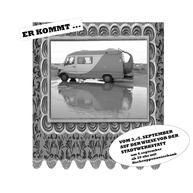 ©
©
After travelling through Italy, France, Spain and Grmany he finally found his way to Linz. From the 3rd to the 5th of September you have the chance to see the only discovered nordic “Schluckwal”. This species eats everything, including a bus and it´s owner, who will invite all her visitors into the belly of the wale, where you can look at all the wonderful objects the wale collected and listen to stunning stories from their journey.
an exhibition from Cimi Czimek
3rd to 5th September all day long in front of the STWST.
4rd September 20:00 h delicious fishsoup is served.
4
Aug
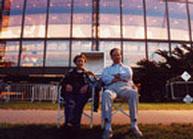 © Sabine Starmayr
© Sabine Starmayr
Music for a landscape-for the Danube and the riverside park adjacent to the Brucknerhaus-is the leitmotif of this year's Klangpark.
A high-performance loudspeaker system delivering superb sound reproduction will be set up to provide an optimal listening experience throughout the alfresco concert venue.
The piece selected for the 2006 Klangpark is Robert Ashley's “Music with Roots in the Aether,” an exciting approach to staging a musical project and combining it with visual forms of expression.
3
Aug
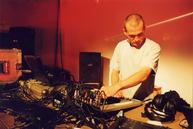 © Sabine Starmayr
© Sabine Starmayr
decker/reiter work on various soundscape ordering patterns behind turntables, computer and synthesizer.
They’ll be followed by staalplaat and a live performance of a mono erosive surround-sound installation entitled “Yokomono” that was singled out for recognition with an Honorary Mention in the 2006 Prix Ars Electronica's Digital Musics category.
DJ ddkern’s extraordinary stylistic mix will conclude the evening with a bang.
3
Aug
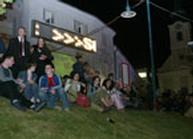 © rubra
© rubra
At day's end, there's nothing like Quarter Nightline in the Stadtwerkstatt to wind things up on a high note.
Fr/Fri 1. 9.
Mr. Scheutz Thomas Scheutz (strom)
Daeque Martin Riedler (strom)
Joachim Knoll (strom)
Trash Kid Martin Huber (saal)
Emix Markus König (saal)
NDL Andreas Liest (saal)
Fino Felix Vierlinger (saal)
Ufuk Ufuk Serbest (saal)
Janosch Janosch Locomono (saal)
Sa/Sat 2. 9.
Martin Klein (saal)
Lena Klein (saal)
Klemens Pisl (strom)
So/Sun 3. 9.
The Dicer Markus Decker (strom)
Herbst Richard Herbst (strom)
Stefan Kushima (strom)
Uwe Walkner (saal)
Mo/Mon 4. 9.
wird nachgesendet
Di/Tue 5. 9.
Guy RabbitWolfgang Ofner (saal)
Metadrain Death Mechanism Johannes Pöll (saal)
Animal Mother Michael Huber (saal)
Ras Rugged Felix schager (strom)
la Oona Valarie Schager (strom)
STWST (AT)
2
Aug
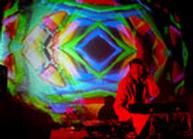 © Pascal Maresch
© Pascal Maresch
In conjunction with the 2006 Ars Electronica’s Campus exhibition, the “Grand Cafe zum Rothen Krebsen,” the Institute for Expanded Art’s event space, will provide an ideal setting for sound- and performance-based projects.
The exhibit will showcase works from the Media Lab Helsinki as well as by regional artists and groups. Rounding things out will be an all-evening Finnish-Austrian DJ set, simulations of the northern lights, and live acts.
2
Aug
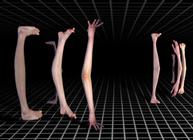 © Klaus Obermayer
© Klaus Obermayer
Following the successful virtual staging of Richard Wagner’s “Das Rheingold” (2004) and Gustav Mahler’s Symphony Nr. 2 in C Minor (2006), the Ars Electronica Futurelab and the Brucknerfest now carry on their series of collaborative efforts with a performance of “Le Sacre du Printemps” (The Rite of Spring).
In “The Making of Stravinsky,” the audience will attend a public rehearsal and experience how the Bruckner Orchestra conducted by Dennis Russell Davies and Karen Kamensek, dancer Julia Mach and the computer artists prepare for the performance of Igor Stravinsky's “Le Sacre du Printemps” together with the accompanying visuals.What's special about this performanceis its interactive combination of orchestral music and computer visualizations.
Susanne Scheel, curator and organizer of the VJ contest at the International Video Festival in Bochum, Germany, will briefly discuss the history and modern forms of synaesthesia. Horst Hörtner of the Ars Electronica Futurelab and media artist Klaus Obermayer will elaborate on the project’stechnical and artistic aspects.
On September 10, 2006 at 8 PM,“Le Sacre du Printemps” will be performed as part of the opening concert of the 2006 Brucknerfest in combination with the classical Klangwolke conducted by Dennis Russell Davies and Karen Kamensek.
1
Aug
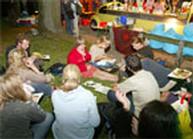 © rubra
© rubra
The object of this game is to temporarily lay claim to a public space and impart a design to it in a very unconventional way. The players-all 100-200 of them-are issued little flags of different colors; they then form a square on a slope of Schloßberg, a hill overlooking Linz.
Pedestrians on the nearby Nibelungen Bridge or in the Urfahr neighborhood are invited to call in requests for patterns they'd like to see on Schloßberg. The players on Schloßberg then jointly attempt to visually implement the requested image,choosing the appropriate colors and waving the corresponding flags.
To pre-register as a player: spiel@afo.at or 0664/954 96 57.
Afterwards, all players are invited to partake of a buffet!
Sonja Meller (AT)
31
Jul
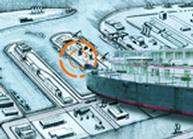 © Ars Electronica Center
© Ars Electronica Center
Increasing complexity evokes a yearning on the part of many people for a simpler life, one that is more down-to-earth and rooted to one’s native soil. People long for simplicity in the traditional sense, and the opening event reflects this longing.
Linz's industrial harbor and an old-fashioned paddle steamer form a mutually complementary, ready-made backdrop for the climax of the first day's activities and the big kick-off of the Festival week. Performances, interventions, music and visualizations ring in the Ars Electronica Festival.
We'll also be offering festivalgoers the opportunity to soak up the nocturnal atmosphere of the Linz harbor during an approximately halfhour cruise aboard the Eduard.
Abfahrtzeiten/Departures: 20:30; 21:30, 23:30; 24:30
22
Jul
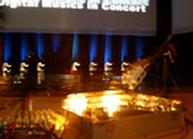 © rubra
© rubra
Eliane Radigue (FR), the Golden Nica recipient in the Digital Musics category, Joe Colley (US) and other Prix Ars Electronica prizewinners are conceiving and putting on a very special concert featuring live performances.
L’île re-sonante
According to Eliane Radigue, “L’îIe re-sonante” (The Resonating Isle) was inspired by a moment in which the musician saw an island in a lake while the water reflected her face. Such an image is two elements in one—a “real” picture and an optical illusion. The depth of the water is reflected by the deeper tones; the higher tones float above them like the island jutting out of the water.
Eliane Radigue emphasizes the transparency on which the work is primarily based, and cites as an additional source of inspiration the moment at which the last strains of a piece of music resonate in listeners’ ears while they simultaneously prepare to partake of new sounds—a fleeting moment that extends “no longer” and anticipates “not yet.”
Eliane Radigue composes electro-acoustic music. In the early ‘50s, she was one of the pioneers of this genre (together with Pierre Schaeffer and Pierre Henry). The same consistency and economy with which she works exclusively with an ARP synthesizer has characterized her musical mode of expression for decades. Lately, she has been discovered as a model by a younger generation of musicians.
Eliane Radigue (FR) - Goldene Nica Digital Musics: L’île re-sonante
Joe Colley (US) - Distinction Digital Musics: psychic stress soundtracks
Yvonne Cornelius (DE) - honorary mention Digital Musics: Niobe
Emanuel Jauk (AT) - honorary mention u19 - freestyle computing
Joe Colley (US)
Eliane Radigue (FR
21
Jul
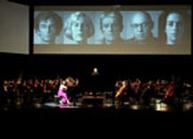 © rubra
© rubra
7:30 PM, Lentos
Ludger Brümmer: Move - for piano, live electronics and video (Premiere)
8:30 PM, Brucknerhaus, Main Hall
Philippe Manoury: Sound and Fury, for a full orchestra (1999); John Cage: Concerto for Prepared Piano and Chamber Orchestra (1951)
Performers: Maki Namekawa and the Bruckner Orchestra Linz conducted by Dennis Russell Davies
9:30 PM, Klangpark
Sonic Projections
10 PM Brucknerhaus
Charles Amirkhanian: Loudspeakers (for Morton Feldmann), (1990)
10:40 PM
Ryoichi Kurokawa: audiovisual crossmedia concert
11:10 PM
Naut Humon
Charles Amirkhanian (US)
Brucknerorchester Linz (AT)
Ludger Brümmer (DE)
John Cage Dennis Russell Davies (US)
Naut Humon (US)
Ryoichi Kurokawa Philippe Manoury Maki Namekawa (JP)
20
Jul
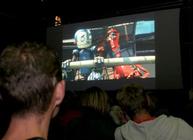 © Quelle: rubra
© Quelle: rubra
A big-screen showing of the prizewinning works in the 2006 Prix Ars Electronica’s Computer Animation / Visual Effects category.
458nm - Jan Bitzer, Ilija Brunck, Tom Weber / Filmakademie Baden Württemberg (DE)
Kein Platz für Gerold - Daniel Nocke (DE) / Studio FILM BILDER
NEGADON: The Monster from Mars - Jun Awazu (JP)
Kakurenbo: Hide and Seek - Shuhei Morita, Shiro Kuro (JP) / YAMATOWORKS
MTV: “Crow” - Marco Spier, Marie Hyon (US) / PSYOP
renaissance - Christian Volckman (FR) / onyx films
The Regulator - Philippe Grammaticopoulos (FR)
Discord: metal and meat - Stephan Larson (US)
Strasse der Spezialisten - Saschka Unseld, Jakob Schuh (DE) / Studio Soi GmbH & Co. KG
Co-production cine plus Media
CAFARD - Thomas Leonard, Guillaume Marques, Paul Jacamon (FR) / SUPINFUCOM
Als ich hier angekommen bin - Perrine Marais (DE) / Filmakademie Baden-Württemberg
Rexona – Stunt City - The Mill (UK)
Shinsatsu-Shitsu (Consultation Room) - Kei Oyama (JP)
Sin City - Stu Maschwitz (US) / The Orphanage
ONE MAN BAND - Mark Andrews, Andrew Jimenez (US) / Pixar Animation Studios
20
Jul
Events, Concerts & Performances | posted by Maria Hieslmayr | at 09:08:00
Visualisierte Linzer Klangwolke
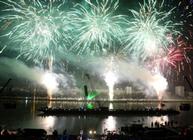 © Quelle: rubra
© Quelle: rubra
The situation of the world’s children is the theme of the 2006 Klangwolke (cloud of sound). Dutch songwriter and poet Herman van Veen will personally relate in word and song the story of Alfred Jodocus Kwak, a duck who’s involved as UNICEF’s ambassador for children’s rights. The 60th anniversary of the United Nations children’s aid organization also provides a fitting occasion for the Klangwolke to go into the living conditions of children around the world.
Hermann van Veen (NL)
19
Jul
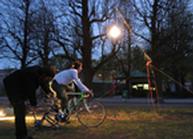 © Assocreation
© Assocreation
On Linz’s Main Square, cyclists will be hooking up their bikes to one of the many generators set up there waiting for them to provide the muscle power needed to charge a giant battery. Each revolution of every set of pedals moves the battery charge indicator a little closer to full. At a prearranged time after sundown, the cyclists’ output will be switched directly to a balloon floating above; the harder they pedal, the brighter the artificial moon glows in the night sky. The humming of the muscle-powered generators will spread out a blanket of sound across the square. During the night, the battery charged during the day will discharge and the moon will gently set over Linz.
Assocreation (AT)
19
Jul
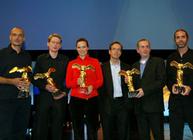 © Quelle: rubra
© Quelle: rubra
An evening totally devoted to the artists. The grand opening event is the first highlight of the 2006 Festival. At the top of the evening’s agenda: presentation of the Golden Nicas to the Prix Ars Electronica prizewinners.
18
Jul
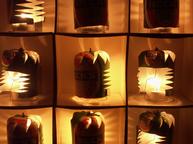 © Aram Bartholl
© Aram Bartholl
Each individual pixel of Random Screen is an independent unit. Core components are a projection foil, a modified beer can and a small tea candle. The candle serves as a source of light; at the same time, the warmth it gives off sets the modified beer can in motion. The can, modified into a sort of freely rotating fan mounted above the candle, can spin around freely. The candlelight shines through a window cut in the beer can onto a projection surface and makes the pixel light up. Depending on how fast the fan spins, it turns the respective pixel either on or off. The larger the candle’s flame, the brighter the pixel shines and the faster its switching frequency. The candlelight is diffused on a second projection foil in the middle of the pixel box in order to make it possible to brighten or dim the pixel as gently as possible. The individual pixels stacked on top of and next to one another form the Random Screen. The small format of the pixels allows the surface of the screen to be expanded at will and this construct’s simple components make it easy for others to copy.
Aram Bartholl (DE)
18
Jul
 © Tsuyoshi Ozawa
© Tsuyoshi Ozawa
Following in the footsteps of Dada and Fluxus artists, Ozawa adapts subcultural visual languages to suggest political and social transformation and uses humor and interaction to break down stereotypes. In Museum of Soy Sauce Art, 1998-2000, he used soy sauce as a drawing medium to create parodies of historical Japanese masterpieces. The ongoing work, Vegetable Weapon, begun in 2001, presents photographs of people holding foodstuffs arranged in the shape of a gun. Each of these “weapons” composed using the ingredients of that person’s favorite local dish. That a gesture of conflict can become an opportunity for sharing suggests that enmity and friendship sometimes represent two side of the same coin.
Tsuyoshi Ozawa (JP)
17
Jul
Events, Concerts & Performances | posted by Maria Hieslmayr | at 15:49:00
The Cell Atlantic CellBooth
 © Jenny Chowdhury
© Jenny Chowdhury
The portable phone booth, which I call the "Cell Atlantic CellBooth", is a wearable object you can carry around with you and set up when you need a moment to talk. The project prompts people to take stock in how cell phone technology has altered the ways in which we communicate with each other and the environment surrounding us.
Jenny Chowdhury (US)
17
Jul
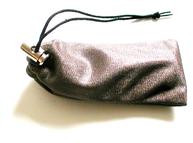 © Aram Bartholl
© Aram Bartholl
The “Silver Cell” cell phone carrying case works like a Faraday cage. A cell phone placed inside this case can neither transmit nor receive. The material it’s made of, a completely silver-coated polyamide fabric, remains transparent, so a modern cell phone’s display can be read through it.
“Silver Cell” makes it possible to evade any positioning or tracking activity by the telecommunications service provider. The user’s own personal dead-zone assures that he/she is the one who decides whether to leave behind a trace in any spatial data model.
Aram Bartholl (DE)
16
Jul
 © Marenka Deenstra/ Jonathan den
© Marenka Deenstra/ Jonathan den
PingPongPixel: a new kind of output device for your computer, consisting out of 8100 table tennis balls in 6 greytones. It's 2 by 3 meters and comes with a pretty slow refresh rate, only 2.5 hours ! What more would you want? We saw it as a big challenge to build an output device which would not use light as a medium.
A system which would stand in contrast to other information displays, which are designed with readability and efficiency in mind. We wanted a display-device that is not very well suited to present important or transient information. A system which is interactive, has a slow refresh rate, is adaptable, intriguing, basic and entertaining.
Marenka Deenstra (NL)
Jonathan den Breejen (NL)
16
Jul
![]() © Aram Bartholl
© Aram Bartholl
Paperpixel is a manually controlled, black & white display with a 6x6-pixel resolution. The 36 pixels are illuminated from the rear by a string of Christmas tree lights with one bulb positioned behind each pixel. The individual pixels are activated by a system resembling an old-fashioned barrel-organ, one that uses a wide paper strip programmed like keypunched computer cards.
Aram Bartholl (DE)
Blog Authors:
Maria Hieslmayr Cornelia Sulzbacher Wolfgang Bednarzek Gerda Hinterreiter Didi Offenhuber Beta Lounge Artists David Cuartielles Sonja Meller StWSt denCity.net
Search:
Categories:
Conferences Animation Festival Events, Concerts & Performances Campus Exhibitions e-lobby Prix Ars Electronica
Recent Posts:
Photographs of the 2006 Festival Media lab thanks! Ars Electronica Center FM4 Live from Ars Electronica in Linz
Archives:
Posts 40 - 20 Posts 20 - 0


